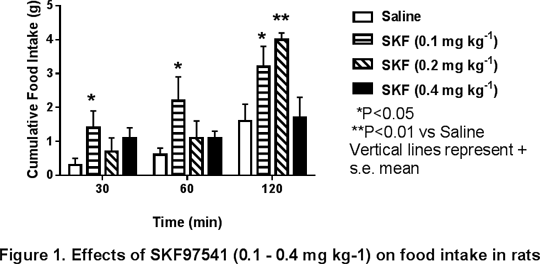Effects of intraperitoneal administration of the GABAB receptor agonist SKF97541 (3-aminopropyl(methyl)phosphinic acid) on food intake in non-deprived rats.
The GABAB receptor agonist baclofen has been shown to increase short-term food intake in rats by a GABAB receptor mediated mechanism (see ref.1). The present study, which was ethically approved, was undertaken to extend these observations by investigating the effects of systemic administration the potent GABAB receptor agonist SKF97541 (SKF; 2) on food intake in non- deprived rats. Experiment 1: Male Wistar rats (n=6; b.wt.380 – 420 g) with free access to food and water at all timeswere injected i.p. with either physiological saline or SKF (0.1, 0.2 or 0.4 mg kg-1) and placed individually in separate experimental cages and food intake measured as described previously (1). Experiment 2: Male Wistar rats(n=6 in each of 2 group) were chronically treated with either saline or SKF (0.4 mg kg-1; i.p.) for 5 days, and food intake measured immediately after administration on the 5th day, as described above. Cumulative food intake data was analysed by ANOVA and the post-hoc Tukeytest. The results for Experiment 1 are shown in Figure 1. SKF(0.1 and 0.2 mg kg-1) significantly increased cumulative food intake over the 2h measurement period. By contrast, the 0.4 mg kg-1 dose had no effect on food intake compared with control data. However, the 4 mg kg-1dose produced ataxia and sedation in most of the rats that lasted for between 15 and 30 min, and these effects may have competed with feeding behaviours (see 3). In Experiment 2, it was observed that tolerance developed to the ataxic and sedative effects of SKF (0.4 mg kg-1) with daily administration, and that the drug significantly increased food intake compared with control data on day 5. Thus, for example, the mean food intake (g) ± s.e. mean measured at 2h was as follows: Saline = 2.4±0.5g; SKF = 4.4 ±0.8g (P<0.05). The results of this study with the potent GABAB agonist SKF extend previous observations with baclofen (1, 3), and provide further support for a role of GABAB receptors in the regulation of food intake.
(1) Ebenezer, I.S. and Pringle, A.K. (1992) Neuropharmacol 31: 39 – 42 (2) Seabrook, G.R. et al. (1990) Br J Pharmacol 101: 949 – 957. (3) Bains, R.S. and Ebenezer, I.S. (2013) Eur J Pharmacol 698: 267-271
|



